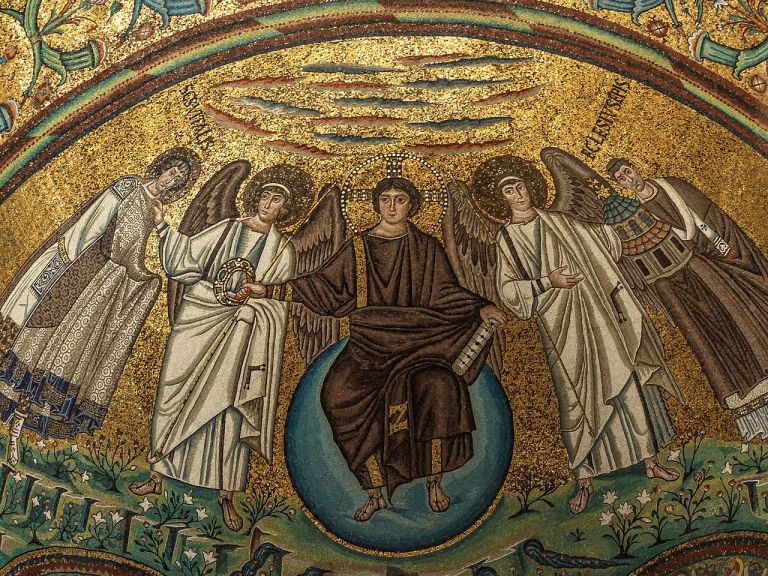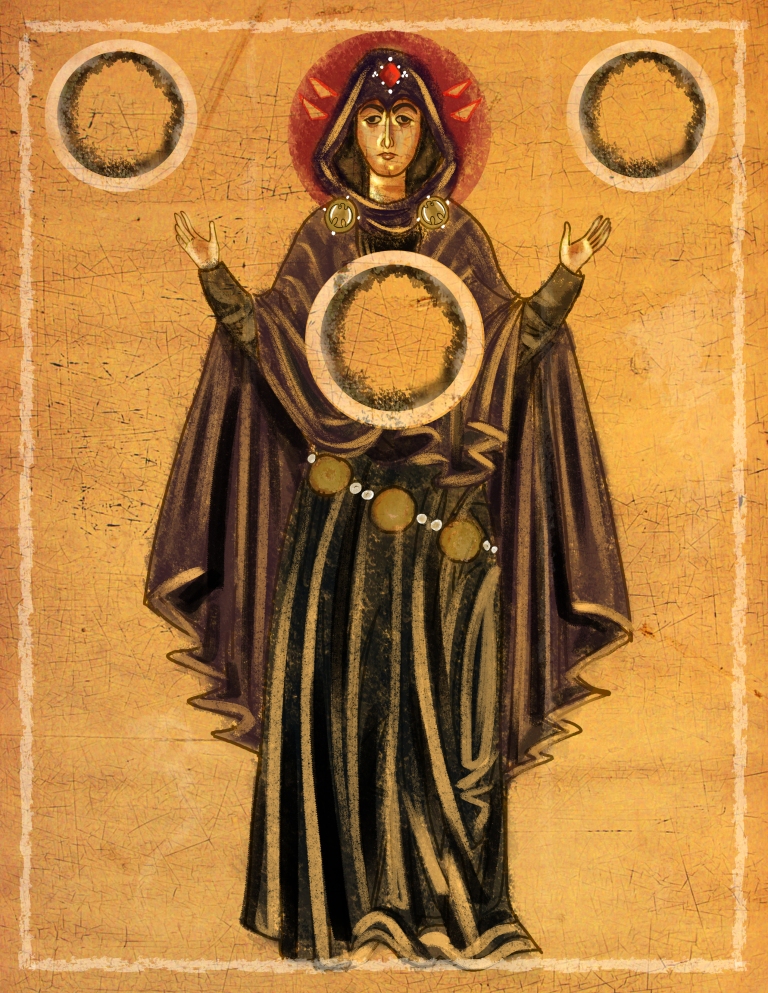There is a story told through history of a man led by divine vision to create a new home for the religion of Christianity- and with a point of his lance, Emperor Constantine declared Byzantium that home. Thus, “Constantinople” was born- and with it, the rise of Christian Art.
Artwork through the ages often follows the mindset of the culture at the time, and the Byzantine Era is no exception. Abandoning the idolization of Greco-Roman Gods and the emphasis of the ideal, natural form, The Byzantine Era depicted their style as a flat, visually consistent window into religious narrative. Much of the art and architecture up to this point was destroyed in an attempted purge on Idol worship. In the ruins of this former life stood Churches and centers for the newly adopted Christianity. This resulted in the loss of the advances in technology and artistic studies previously held by society. As a result, the “Byzantine Style” was rooted in what was beyond what our eyes really see- to which perspective and anatomy are no longer relevant.
Art & Architecture
At it’s foundation- Constantine envisioned a “New Rome”. Like Rome, Constantinople had seven hills and was divided into fourteen regions; there was even a Capitoline Hill. [1] Though Christian architecture was intended to be a visual successor to it’s Greco-Roman ancestor, much of the knowledge needed to create the rounded structures [such as the Parthenon in Rome] was no longer around to reference. These constructions have an original appearance; what is especially remarkable is the tendency to substitute curves for straight lines, archways for shouldered flat arches.
This resulted in an original style of architecture, one that often replaced curves with straight lines, archways for flat arches, and opaque ceramic with decorated structure. We also see a lot of augmentation to traditional Roman structure, such as the basilica form. As opposed to a true cylindrical foundation, the construction begins in a cubic form which is then rounded at the top to create the “bell” shape which we are very familiar with today. [2]

The pinnacle of Byzantine architecture is the Hagia Sofia, which was built under Justinian’s rule at the start of the 6th century. This massive structure and feat of engineering was the birthplace of Byzantine art as we know it- encasing within its walls a large number of new artistic practices such as de-materialization through painting, decoration and mosaic. The visual style had gone beyond traditional Roman architecture and entered a realm of it’s own that was perceived as unrecognizable. [3] The influence of this astounding site spread to Italy, where the Basilica of San Vitale gives us a great point of reference for the emerging Byzantine Style.

The Byzantine mosaic served as a snapshot of the narrative of Christianity that existed in a world beyond our own. The Artist was tasked with creating an image on word alone, in stark contrast to the Greco-Roman style of direct observation and realism. As Christianity governed much of the lifestyle in this period, the subject matter for artwork existed as such. As a result, the visual language of the Byzantine era consisted of a relatively consistent style that is easily recognizable. Let’s take the image above as an example.
Artwork from this period relied heavily on Iconography and symbols, and this Christ Enthroned is no exception to that. The use of shape allows us to identify the subjects of the image. As typical of this period, Jesus is seen with a cylindrical halo around his head. Saints and important Holy Icons will often appear with the same shape, as you can see from the two Angels and Saint to the left. However, the icon of the cross appearing in Jesus’s halo, as well as his position at the center of the composition serves as good indication of who he is. A simple ground plane is shown, however a majority of the space in this work is depicted as a golden abyss of sorts. The background of artwork throughout this period is not as relevant since the artists of the time were more focused on portraying the icons. Color is notably used here in the blue circle we see appear around Jesus, which is meant to suggest the window to the Heavens that exists in another plane of existence. The defining visual style of Byzantine art is depicted here with the way the figures are addressed. Less concerned with realism, the figures throughout this period are often shown with these elements: a long nose, hard lines, simple eye shape, and no real sense of gender. The figures are shown as if they are flat, showing no real sense of movement until much later in the period.
Replicating Byzantine Art
Designing a Superhero in the style of Byzantine Artwork
The process of translating a famous character into this style of work proved to be quite the challenge, and I was faced with many difficult design hurdles to overcome. My initial approach was to pick a comic book character that I was fond of, simply because I liked them, and try to find reference that fit the character. This ended in two failed attempts, for the references I referred to ended up being off type or too obscure with little information about them. After much frustration, I decided to see what it would be like if I flipped the script, and dove deep into typical works from the period to get an understanding of the types of shape language and narrative before picking my character. This process was much more successful, and resulted in a piece I am satisfied with.
I started my search with a few key elements I wanted to be thinking about while taking in all that the Byzantine era had to offer. These were how important icons were highlighted, how clothing and jewelry were used to portray the icon, and the way that a story was able to be conveyed with only a few elements. I found two main types of references that fit my needs: depictions of The Virgin and Jesus, and portrayal of Royalty.


I noted a few things from these works-
- Purple is an expensive color and was difficult to achieve vibrantly in this time period, thus it was saved for Royalty and people being depicted as Royalty, as seen with the Virgin and Child.
- Jewelry was also saved for Royalty, though it was still treated in a fairly flat way in terms of color
- Drapery remains consistent in terms of the way it is drawn
- Symbols are used sparingly but intelligently- a few will say enough without overwhelming the image.
Thus, I created my image. My goal was to depict the DC hero Raven in an Icon painting style from a later section of Byzantine History.

Raven is a DC Universe hero who also happens to be the daughter of a demon King named Trigon. I thought this posed a fun, dichotomous opportunity to depict a demon in the style of a character that is known for holiness. The location of the traditional halo appearing behind the figure helped spark my idea, for Raven’s connection to her father and her demon side are something she literally tries to put behind her. There are a few key elements of Raven as a character that seemed to fit well within this style- such as her iconic cloak, the appearance of her superpowers (which happen to be circles of dark matter), and the design of her outfit.
Pose/Composition Reference

Raven’s Symbols
Thanks for reading!
[1] Milyayeva, Lyudmila. Icons. New York: Parkstone International, 2014. Accessed October 1, 2018. ProQuest Ebook Central.
[2]Bayet, Charles. Byzantine Art, Parkstone International, 2012. ProQuest Ebook Central, https://ebookcentral.proquest.com/lib/digipen-ebooks/detail.action?docID=886849.
[3] Eastmond, Antony. Art and Identity in Thirteenth-Century Byzantium : Hagia Sophia and the Empire of Trebizond. Florence: Routledge, 2017. Accessed October 2, 2018. ProQuest Ebook Central.




